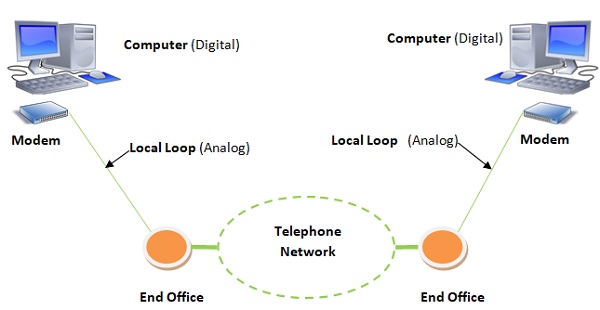
 Data Structure
Data Structure Networking
Networking RDBMS
RDBMS Operating System
Operating System Java
Java MS Excel
MS Excel iOS
iOS HTML
HTML CSS
CSS Android
Android Python
Python C Programming
C Programming C++
C++ C#
C# MongoDB
MongoDB MySQL
MySQL Javascript
Javascript PHP
PHP
- Selected Reading
- UPSC IAS Exams Notes
- Developer's Best Practices
- Questions and Answers
- Effective Resume Writing
- HR Interview Questions
- Computer Glossary
- Who is Who
Telephone Modems
Modem is an abbreviation of "modulator demodulator". It is a network device that modulates digital information or bits into analog signals for transmission at the sending end, and demodulates the analog signals to bits at the receiving end. Telephone modems enables data communication between two computers over voice - grade telephone lines.
Purpose and Usage
The computers are digital devices that are connected via analog local loops of the telephone networks. So, there is a need to convert the bits to analog signals so that they can be transmitted via the physical channels; and conversely convert analog signals in the local loops to computer understandable bits. So a modem is placed at the interface of computer and local loop.

Modulation Technique
Data communication speed over telephone lines are restricted by bandwidth. So, Trellis Coded Modulation (TCM) is being popularly used to enhance speed as well as reduce transmission errors.
Standards for Modems
ITU-T defines a set of standards and specifications for modems for sending data across telephone lines. Some of the popular standards are −
V.32 − It has a data rate of 4.8 Kbps or 9.6 Kbps. It uses 32 constellation points to transmit 4 data bits per symbol. It operates as full-duples on 4-wire circuits and as half-duplex on 2-wire circuits.
V.34 − It is a full duplex modem with data rate of 28.8 Kbps that transmits 12 data bits per symbol. The latest V.34 modems transmit 14 bits per symbol achieving data rates of 33.6Kbps.
V.90 and V.92 − They are used for asynchronous full duplex transmissions. They achieve download speeds (from telephone provider to computer) of 56 Kbps and upload speeds (computer to provider) of 33.6 Kbps or 48 Kbps.

